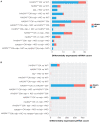Dysregulation of MicroRNAs and PIWI-Interacting RNAs in a Caenorhabditis elegans Parkinson's Disease Model Overexpressing Human α-Synuclein and Influence of tdp-1
- PMID: 33762903
- PMCID: PMC7982545
- DOI: 10.3389/fnins.2021.600462
Dysregulation of MicroRNAs and PIWI-Interacting RNAs in a Caenorhabditis elegans Parkinson's Disease Model Overexpressing Human α-Synuclein and Influence of tdp-1
Abstract
MicroRNAs (miRNAs) and PIWI-interacting RNAs (piRNAs) regulate gene expression and biological processes through specific genetic and epigenetic mechanisms. Recent studies have described a dysregulation of small non-coding RNAs in Parkinson's disease (PD) tissues but have been limited in scope. Here, we extend these studies by comparing the dysregulation of both miRNAs and piRNAs from transgenic Caenorhabditis elegans (C. elegans) nematodes overexpressing pan-neuronally human α-synuclein wild-type (WT) (HASNWT OX) or mutant (HASNA53T OX). We observed 32 miRNAs and 112 piRNAs dysregulated in HASNA53T OX compared with WT. Genetic crosses of HASNA53T OX PD animal models with tdp-1 null mutants, the C. elegans ortholog of TDP-43, an RNA-binding protein aggregated in frontal temporal lobar degeneration, improved their behavioral deficits and changed the number of dysregulated miRNAs to 11 and piRNAs to none. Neuronal function-related genes T28F4.5, C34F6.1, C05C10.3, camt-1, and F54D10.3 were predicted to be targeted by cel-miR-1018, cel-miR-355-5p (C34F6.1 and C05C10.3), cel-miR-800-3p, and 21ur-1581 accordingly. This study provides a molecular landscape of small non-coding RNA dysregulation in an animal model that provides insight into the epigenetic changes, molecular processes, and interactions that occur during PD-associated neurodegenerative disorders.
Keywords: Caenorhabditis elegans; PIWI-interacting RNA; microRNA; neurodegenerative disease; synucleinopathies.
Copyright © 2021 Shen, Wang, Chen and Wong.
Conflict of interest statement
The authors declare that the research was conducted in the absence of any commercial or financial relationships that could be construed as a potential conflict of interest.
Figures





Similar articles
-
TDP-1/TDP-43 potentiates human α-Synuclein (HASN) neurodegeneration in Caenorhabditis elegans.Biochim Biophys Acta Mol Basis Dis. 2020 Oct 1;1866(10):165876. doi: 10.1016/j.bbadis.2020.165876. Epub 2020 Jun 9. Biochim Biophys Acta Mol Basis Dis. 2020. PMID: 32531261
-
PIWI-interacting RNA expression regulates pathogenesis in a Caenorhabditis elegans model of Lewy body disease.Nat Commun. 2023 Oct 2;14(1):6137. doi: 10.1038/s41467-023-41881-8. Nat Commun. 2023. PMID: 37783675 Free PMC article.
-
MicroRNA expressing profiles in A53T mutant alpha-synuclein transgenic mice and Parkinsonian.Oncotarget. 2017 Jan 3;8(1):15-28. doi: 10.18632/oncotarget.13905. Oncotarget. 2017. PMID: 27965467 Free PMC article.
-
Small RNAs in parasitic nematodes - forms and functions.Parasitology. 2020 Jul;147(8):855-864. doi: 10.1017/S0031182019001689. Epub 2019 Dec 17. Parasitology. 2020. PMID: 31843030 Free PMC article. Review.
-
microRNA dysregulation in neurodegenerative diseases: A systematic review.Prog Neurobiol. 2019 Nov;182:101664. doi: 10.1016/j.pneurobio.2019.101664. Epub 2019 Jul 26. Prog Neurobiol. 2019. PMID: 31356849
Cited by
-
Adipocyte, Immune Cells, and miRNA Crosstalk: A Novel Regulator of Metabolic Dysfunction and Obesity.Cells. 2021 Apr 24;10(5):1004. doi: 10.3390/cells10051004. Cells. 2021. PMID: 33923175 Free PMC article. Review.
-
Unraveling Dysregulated Cell Signaling Pathways, Genetic and Epigenetic Mysteries of Parkinson's Disease.Mol Neurobiol. 2024 Nov;61(11):8928-8966. doi: 10.1007/s12035-024-04128-1. Epub 2024 Apr 4. Mol Neurobiol. 2024. PMID: 38573414 Review.
-
Dysregulation of Human Somatic piRNA Expression in Parkinson's Disease Subtypes and Stages.Int J Mol Sci. 2022 Feb 23;23(5):2469. doi: 10.3390/ijms23052469. Int J Mol Sci. 2022. PMID: 35269612 Free PMC article.
-
Systemic RNA Interference Defective (SID) genes modulate dopaminergic neurodegeneration in C. elegans.PLoS Genet. 2022 Aug 19;18(8):e1010115. doi: 10.1371/journal.pgen.1010115. eCollection 2022 Aug. PLoS Genet. 2022. PMID: 35984862 Free PMC article.
-
The role of noncoding RNAs in Parkinson's disease: biomarkers and associations with pathogenic pathways.J Biomed Sci. 2021 Nov 18;28(1):78. doi: 10.1186/s12929-021-00775-x. J Biomed Sci. 2021. PMID: 34794432 Free PMC article. Review.
References
Grants and funding
LinkOut - more resources
Full Text Sources
Other Literature Sources

